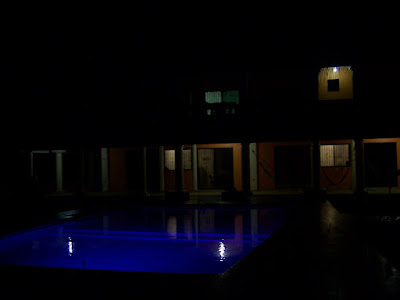
This is putting the cart before the horse, discussing water distillation before a house.
Sufficient to say I will get to the house/hotel we are building.
The 1st question is why bother with a water still?
Water is currently about 10 pesos (1.00) for a 20 litre Garafon (5 gallon container) delivered to the door. Presumeably this is water that is processed through a membrane filter. Unfortunately my wife and others have seen bottles being filled at the car wash amongst other things. Also as we have seen in past years after tropical storms, the time of most rain is typically the time bridges are out, water pump stations destroyed and no water arrives in the town plumbing.
I have found a couple references on the internet to water stills both commercial and self made
http://www.thefarm.org/charities/i4at/surv/sstill.htm
it seems the self made units started with experimentation with concrete and went to lighter materials. However even the beach at Tapachula is not a desert, there are dry spells such as March but still the possibility of 2 meters of rain a year. Consequently with the hot sun and ample moisture wood is subject to rot. In fact till you have lived in the tropics it is hard to imagine the corrosive nature of the environment.
6 months of sun and rain can ruin a paint job on a vehicle. Salt from the beach combined with moisture can eat up steel in a year.
With this in mind I felt for a solar distiller to survive I would have to go back to concrete and glass. I am doing it with a different material though. A combination of foam and steel triangles called various names Tridi Panel of
www.Tridipanel.org
www.Tridipanel.com
www.Tridipanel.com.mx
or
Combitech by another supplier in southern Mexico.
You might also want a sulphate resistant type cement, type 50.
I thought to use a patio door size piece of glass as mentioned in other references but investigated the standard glass size in Mexico which is 1.8 meter x 2.6 meter and the thickest standard available is 6 milimeter for only 450 pesos or $45.00. Cut glass may be double but we found a glass shop willing to provide a single cut for 30 peso if we bought the entire sheet of glass. This gave me 2 sheets of a size of 1.8meter x 1.3 meter.
The glass cutters use pieces of used rubber inner tube to handle the glass. Its worth a few pesos to have several 8 inch x 8 inch or 20cm squares.
The Tridi Panel is available in several multiples of 4' x ?. However we had 4' by 8' for building a house and determined to try with that. The Glass however needs to be on too much of a angle if keeping within the 4 feet width. The Tridi panel has a steel overlap of about 4 extra inches for multiple sheets side by side. Therefore we re.duced the height by going wider about 52" wide, attaching the vertical back to that.
You will notice 6 tubes on the unit.
The clean water drain 1,
Fill 1,
Actual drain of tray in case desiring to flush unit, 1
Fluid level 3,
thinking the unit should not run dry in a day and wanting about 2 times the liquid I felt the maximum evaporation would occur when the minimum water was added that did not run the unit dry or precipitate out solids. It would be easir to have extra fluid levels and experiment.
It appears above water level may be best with white so as to keep air temperature lower to promote cooling of air so as to increase condensation on glass.
The Tridi panel was about $40.00 for a 4x8 foot sheet with 3" foam and total thickness of about 4.5 inch with concrete. 1.5 required per unit so again a benefit to building 2 units at 1 time.
Tridi Panel , 3 pieces $120.00
Glass 1 (2) pieces 48.00
Black cement colorant 5.80 Using in attempt to eliminate need for black silicone
Cement, sand, lime 30.00 ?? Guestimate
Silicone White 2 tubes 9.00 For embedding glass, white to prevent heat build up.
PVC tubing 3/4" 5.00 Guestimate - Used so we could go to 1/2 inch copper if
did not work.
Guess what the PVC tubing looks to be a bad idea, in part because it is not intended to work with hot water and also it will be exposed to lots of UV. I expect to replace or line the PVC with copper and silicone over the exposed PVC. Then use enough copper to get out of the sun and at that point switch to PEX. A plastic tubing intended for hot water usage rated at 50 years. But must not be exposed to lots of sun light. A vendor in Mexico sells a product known as Tubo Plus.
Material cost of 2 units under 150.00 material each.
Will they work to create 5 gallons 20 litres per day each - to be seen, if yes then payback could be under 1 year. If distillation amount is significantly less then units will have less monetary justification. Though having clean water after a tropical storm might be considered priceless.

 2020/03/25 LED lights to replace T5
2020/03/25 LED lights to replace T5




